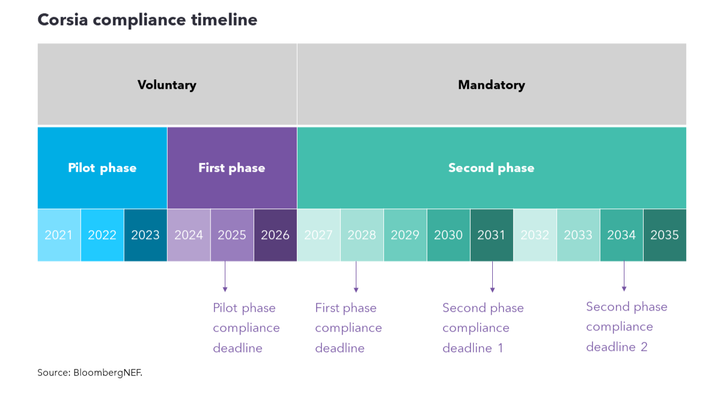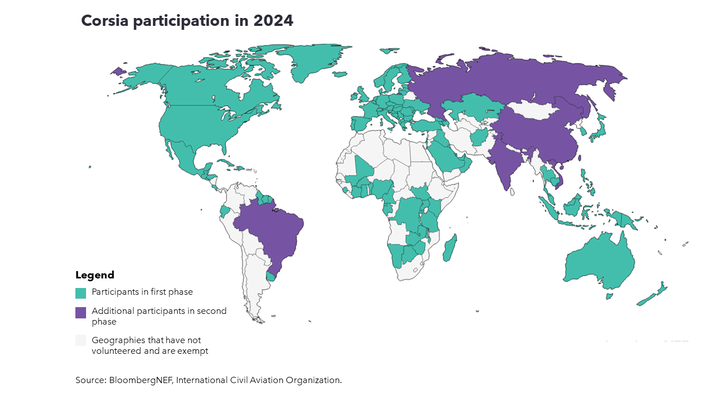Carbon Offsetting and Reduction Scheme for International Aviation (Corsia)
intermediate
|
21 Oct 2024
The Carbon Offsetting and Reduction Scheme for International Aviation – known as Corsia – is a global market-based measure that aims to reduce emissions from flights between countries. In 2024, some 126 economies have opted to participate in Corsia and a further two will join from January 2025.
Under the scheme, airlines and other aircraft operators must surrender credits known as Corsia Eligible Emissions Units to cover their CO2 output above a pre-determined baseline. Alternatively, they can purchase certain Corsia-eligible fuels, or simply cut their emissions.
International aviation is not covered by the United Nations Framework Convention on Climate Change, so decarbonizing the sector is under the purview of the International Civil Aviation Organization. These efforts are important: while international aviation accounts for just 2.5% of global CO2 output, emissions from air travel are growing fast and the sector is hard to decarbonize.
Key message
Corsia aims to reduce emissions from the aviation sector. Under the scheme, airlines are required to decarbonize or purchase either Corsia Eligible Emission Units, or Corsia-eligible fuels, to cancel emissions above a baseline currently set at 85% of 2019 emissions for routes between participating states.
Coverage
The Corsia scheme was adopted by the International Civil Aviation Organization (ICAO) in 2016 as one mechanism to decarbonize the sector. The program covers CO2 released from international flights by aircraft that weigh more than 5,700 kilograms and emit more than 10,000 metric tons of CO2 each year.
It excludes economies with a share lower than 0.5% of total international aviation activity, calculated using 2018 revenue-ton-kilometers, or those that do not fall into the top 90%. Revenue-ton-kilometers are the utilized capacity for passengers and cargo multiplied by distance flown.
Other exemptions include what the UN defines as Small Island Developing States, Landlocked Developing Countries and Least Developed Countries, regardless of their contribution to total aviation activity.
Compliance process
Corsia is being implemented in three phases: pilot phase (2021-2023), first phase (2024-2025), and second phase (2027-2035). The pilot and first phases are voluntary three-year cycles, while the second phase is mandatory and comprised of three compliance cycles: 2027-2029, 2030-2032 and 2033-2035.

The first compliance deadline is January 31, 2025. By this date, airlines must purchase and cancel Corsia Eligible Emissions Units, or use Corsia-eligible fuels for the pilot phase with the compliance cycle 2021-2023.
In the pilot phase, the baseline for emissions was set at 2019 levels, while as of 2024, it was reduced to 85% of that level.
Offsetting requirements are adjusted to account for the growth of the sector, as well as individual operators' emissions from 2033 – the beginning of the third compliance period for the second phase of the scheme – on an annual basis.
Airplane operators are responsible for reporting and monitoring their emissions annually where offsetting requirements are calculated against the baseline. This is then validated by verification bodies.
Operators submit their verified emissions reports to their state authorities, who conduct an order-of-magnitude check, consolidate data, and submit reports to the ICAO registry. ICAO then calculates the annual growth factor, which is communicated to airplane operators by their respective state authorities, alongside their emissions obligations for the scheme year.
Geographical coverage
During the pilot and first phases, members volunteer to join Corsia and only routes between two participants are covered. However, because a limited number of volunteers, including Canada, the UK and European Union, have begun to transpose Corsia into domestic law, there is a risk of non-compliance by other members. There is also a lack of clarity on the penalty of non-compliance and how it will be managed.
For the second phase, all states are subject to offsetting requirements, while those that are exempt can opt in on a voluntary basis.

Corsia Eligible Emission Units
Corsia Eligible Emissions Units may be traded in the global voluntary carbon offset market but must obtain Corsia certification to count towards the scheme. Supply of Corsia-eligible credits for the first phase is limited to projects listed on approved registries. To date, American Carbon Registry and Architecture for REDD+ are the only approved registries, while Verra and Gold Standard remain under conditional approval.
For the second phase of CORSIA, ICAO will begin assessment of eligible projects in 2025. The new guidelines will focus on mitigating ‘permanence risk’ – the threat that emission reductions are reversed in the future.
Corsia-eligible fuels
Aircraft operators can alternatively claim emission reductions by using certain ‘Corsia-eligible’ fuels, like sustainable aviation fuel, and subtracting the emission ‘savings’ from their offset requirements.
This information is submitted by the aircraft operator to their state authority and requires evidence of the purchase of the fuels, as well certification documentation and the values of the lifecycle emissions used to calculate the emissions reduction factor.
If an operator purchases more Corsia-eligible fuels than needed for a certain compliance cycle, resulting in net-negative emissions, it cannot bank the surplus into the next compliance cycle.
Stay up to date
Sign up to be alerted when there are new Carbon Knowledge Hub releases.